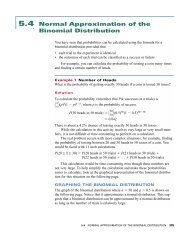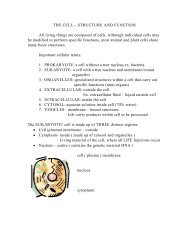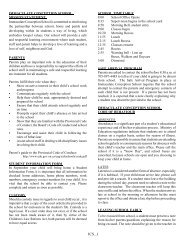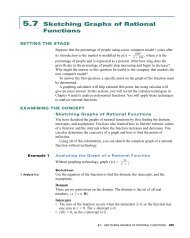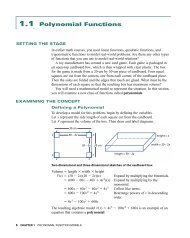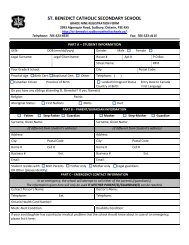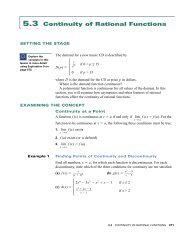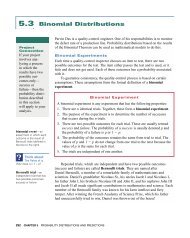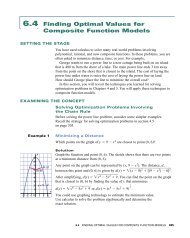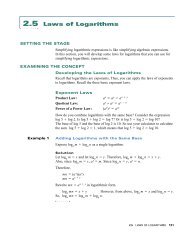Pg 247
Pg 247
Pg 247
You also want an ePaper? Increase the reach of your titles
YUMPU automatically turns print PDFs into web optimized ePapers that Google loves.
13. Fully describe the motion shown in each graph. Refer to direction,<br />
displacement, velocity, and acceleration and include the words positive,<br />
negative, increasing, and decreasing.<br />
(a)<br />
(b) s(t)<br />
s(t)<br />
s<br />
s<br />
t<br />
t<br />
14. Communication: A car screeches to a sudden stop at a stop sign.<br />
Describe the car’s distance from the stop sign, velocity, and acceleration<br />
as positive, negative, large, small, increasing, and decreasing.<br />
Sketch graphs for this situation that show<br />
(a) position versus time<br />
(b) velocity versus time<br />
(c) acceleration versus time<br />
15. Thinking, Inquiry, Problem Solving: A space probe on the surface of Mars<br />
conducts several experiments. It launches a small weight and tracks the<br />
weight’s motion using a motion detector. The table shows the data that the<br />
probe collected.<br />
Time (s) 0.0 0.5 1.0 1.5 2.0 2.5 3.0 3.5 4.0 4.5 5.0<br />
Height (m) 0.50 5.01 8.54 11.09 12.66 13.25 12.86 11.49 9.14 5.81 1.50<br />
(a) Determine the initial velocity of the weight.<br />
(b) Determine the velocity at which the weight falls to the surface of Mars.<br />
(c) Determine the force of gravity on Mars.<br />
(d) If the probe launched the same weight on Earth, with the same initial<br />
velocity, how long would the weight take to return to the ground?<br />
10<br />
8<br />
6<br />
4<br />
2<br />
–2 –1<br />
–2<br />
–4<br />
–6<br />
–8<br />
–10<br />
y<br />
1<br />
2<br />
3<br />
4<br />
5 6<br />
16. A particle moves on a vertical line. Its position, s, in metres at t seconds is<br />
given by s(t) t 3 9t 2 24t, t ≥ 0.<br />
(a) Determine the velocity and acceleration functions.<br />
(b) When is the particle moving up? down?<br />
(c) Find the distance the particle travels between t 0 and t 6.<br />
(d) Graph the position, velocity, and acceleration functions for the interval<br />
0 ≤ t ≤ 6.<br />
x<br />
(e) When is the particle speeding up? slowing down?<br />
17. Check Your Understanding: The graphs of f , f ′, and f ′′ are shown on<br />
the left. Which graphs correspond to which functions? Explain your<br />
reasoning.<br />
A function and its derivatives<br />
254 CHAPTER 3 RATES OF CHANGE IN POLYNOMIAL FUNCTION MODELS



